Top Rankings
School District No. Re-2 Brush ranks among the top 20% of public school district in Colorado for:
Category
Attribute
Graduation Rate
Highest graduation rate (Top 10%)
For the 2025 school year, there is 1 public high school serving 346 students in School District No. Re-2 Brush.
Public High Schools in School District No. Re-2 Brush have a diversity score of 0.52, which is less than the Colorado public high school average of 0.62.
Public High School in School District No. Re-2 Brush have a Graduation Rate of 92%, which is more than the Colorado average of 82%.
The school with highest graduation rate is Brush High School, with 90-94% graduation rate. Read more about public school graduation rate statistics in Colorado or national school graduation rate statistics.
Minority enrollment is 55% of the student body (majority Hispanic), which is more than the Colorado public high school average of 49% (majority Hispanic).
Overview
This School District
This State (CO)
# Schools
4 Schools
552 Schools
# Students
1,429 Students
325,938 Students
# Teachers
87 Teachers
18,376 Teachers
Student : Teacher Ratio
16:1
16:1
District Rank
The school district's graduation rate of 90-94% has stayed relatively flat over five school years.
Math Test Scores (% Proficient)
(18-19)18%
35%
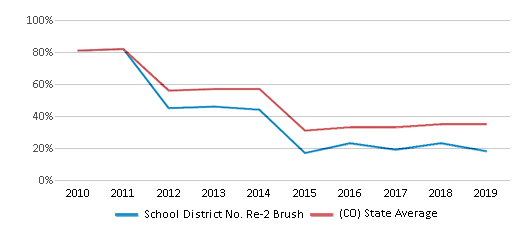
Reading/Language Arts Test Scores (% Proficient)
(18-19)29%
47%
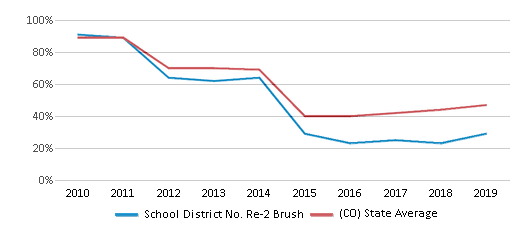
Graduation Rate
90-94%
82%
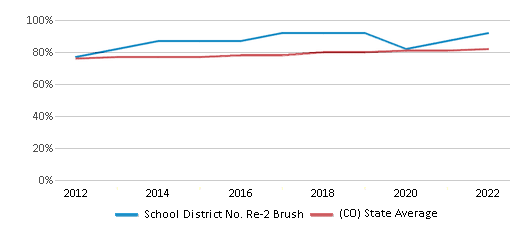
Students by Ethnicity:
Diversity Score
0.53
0.62
# American Indian Students
4 Students
1,995 Students
% American Indian Students
n/a
1%
# Asian Students
5 Students
10,880 Students
% Asian Students
n/a
3%
# Hispanic Students
710 Students
116,766 Students
% Hispanic Students
50%
36%
# Black Students
17 Students
14,465 Students
% Black Students
1%
4%
# White Students
678 Students
165,052 Students
% White Students
48%
51%
# Hawaiian Students
2 Students
1,001 Students
% Hawaiian Students
n/a
n/a
# Two or more races Students
13 Students
15,478 Students
% of Two or more races Students
1%
5%
Students by Grade:
# Students in PK Grade:
174
495
# Students in K Grade:
98
3,076
# Students in 1st Grade:
101
3,320
# Students in 2nd Grade:
104
3,599
# Students in 3rd Grade:
96
3,495
# Students in 4th Grade:
92
3,613
# Students in 5th Grade:
112
3,847
# Students in 6th Grade:
101
6,597
# Students in 7th Grade:
104
8,652
# Students in 8th Grade:
101
9,001
# Students in 9th Grade:
91
68,978
# Students in 10th Grade:
97
69,902
# Students in 11th Grade:
89
68,450
# Students in 12th Grade:
69
72,913
# Ungraded Students:
-
-
District Revenue and Spending
The revenue/student of $16,871 is higher than the state median of $15,473. The school district revenue/student has declined by 7% over four school years.
The school district's spending/student of $16,627 is higher than the state median of $15,791. The school district spending/student has declined by 6% over four school years.
Total Revenue
$24 MM
$13,426 MM
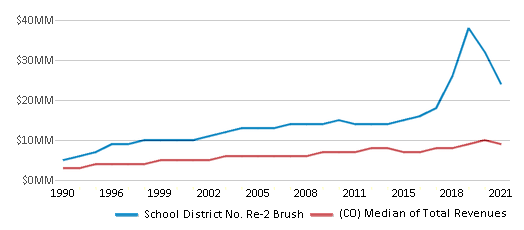
Spending
$24 MM
$13,702 MM
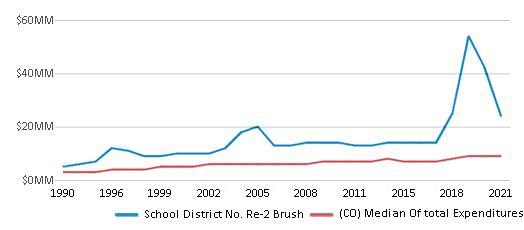
Revenue / Student
$16,871
$15,473
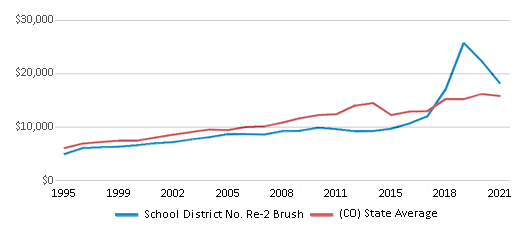
Spending / Student
$16,627
$15,791

Best School District No. Re-2 Brush Public High Schools (2025)
School
(Math and Reading Proficiency)
(Math and Reading Proficiency)
Location
Grades
Students
Rank: #11.
Brush High School
(Math: 25-29% | Reading: 45-49% )
Rank:
Rank:
5/
Bottom 50%10
1600 Mill Street
Brush, CO 80723
(970) 842-5171
Brush, CO 80723
(970) 842-5171
Grades: 9-12
| 346 students
Recent Articles

Year-Round Or Traditional Schedule?
Which is more appropriate for your child? A year-round attendance schedule or traditional schedule? We look at the pros and cons.

Why You Should Encourage Your Child to Join a Sports Team
Participating in team sports has a great many benefits for children, there is no doubt. In this article you will learn what those benefits are.

White Students are Now the Minority in U.S. Public Schools
Increasing birth rates among immigrant families from Asia and Central and South America, combined with lower birth rates among white families, means that for the first time in history, public school students in the United States are majority-minority. This shift in demographics poses difficulties for schools as they work to accommodate children of varying language abilities and socio-economic backgrounds.





